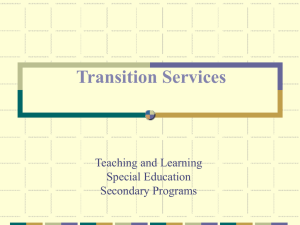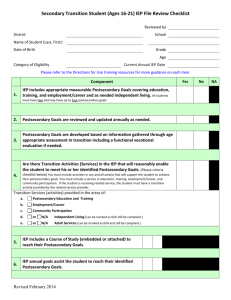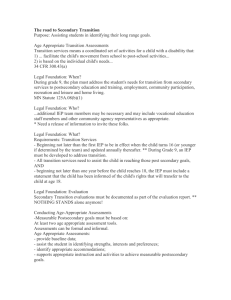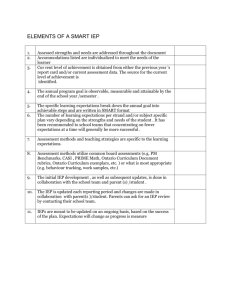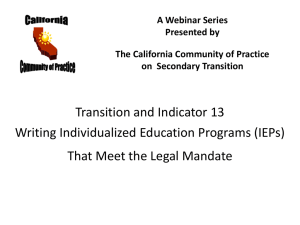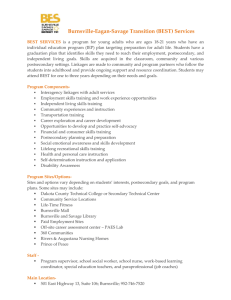Transition Requirements Checklist
advertisement
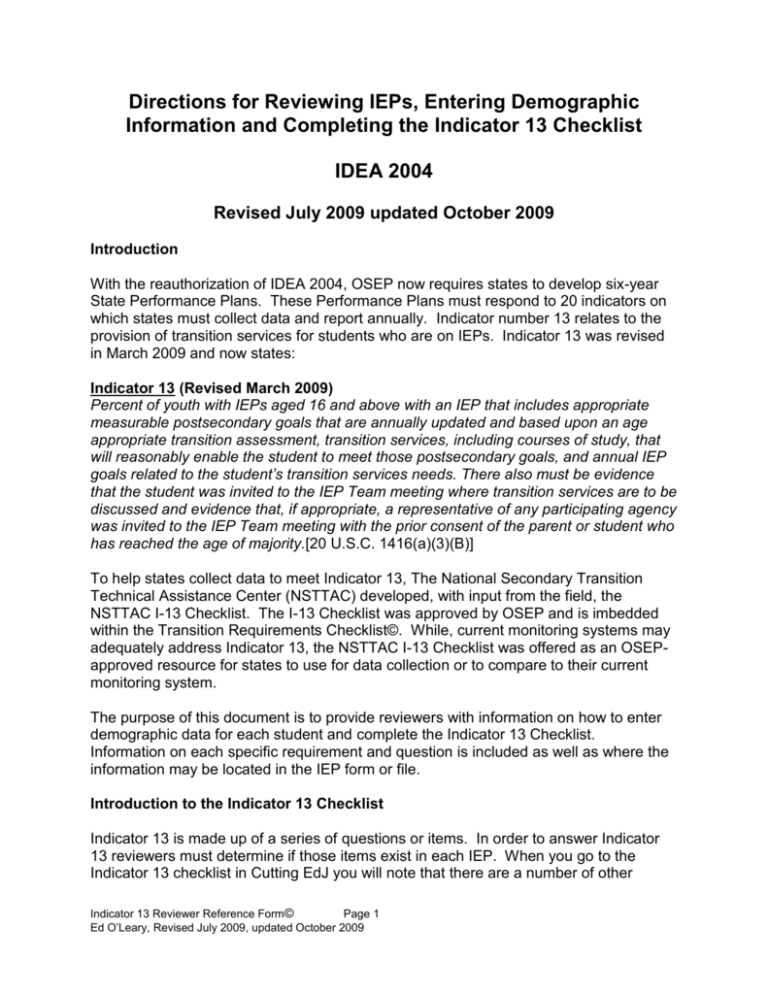
Directions for Reviewing IEPs, Entering Demographic Information and Completing the Indicator 13 Checklist IDEA 2004 Revised July 2009 updated October 2009 Introduction With the reauthorization of IDEA 2004, OSEP now requires states to develop six-year State Performance Plans. These Performance Plans must respond to 20 indicators on which states must collect data and report annually. Indicator number 13 relates to the provision of transition services for students who are on IEPs. Indicator 13 was revised in March 2009 and now states: Indicator 13 (Revised March 2009) Percent of youth with IEPs aged 16 and above with an IEP that includes appropriate measurable postsecondary goals that are annually updated and based upon an age appropriate transition assessment, transition services, including courses of study, that will reasonably enable the student to meet those postsecondary goals, and annual IEP goals related to the student’s transition services needs. There also must be evidence that the student was invited to the IEP Team meeting where transition services are to be discussed and evidence that, if appropriate, a representative of any participating agency was invited to the IEP Team meeting with the prior consent of the parent or student who has reached the age of majority.[20 U.S.C. 1416(a)(3)(B)] To help states collect data to meet Indicator 13, The National Secondary Transition Technical Assistance Center (NSTTAC) developed, with input from the field, the NSTTAC I-13 Checklist. The I-13 Checklist was approved by OSEP and is imbedded within the Transition Requirements Checklist©. While, current monitoring systems may adequately address Indicator 13, the NSTTAC I-13 Checklist was offered as an OSEPapproved resource for states to use for data collection or to compare to their current monitoring system. The purpose of this document is to provide reviewers with information on how to enter demographic data for each student and complete the Indicator 13 Checklist. Information on each specific requirement and question is included as well as where the information may be located in the IEP form or file. Introduction to the Indicator 13 Checklist Indicator 13 is made up of a series of questions or items. In order to answer Indicator 13 reviewers must determine if those items exist in each IEP. When you go to the Indicator 13 checklist in Cutting EdJ you will note that there are a number of other Indicator 13 Reviewer Reference Form© Page 1 Ed O’Leary, Revised July 2009, updated October 2009 questions that are ‘grayed out’. Those questions are used in the TOPs project and, while required under IDEA 2004, they are not used for determining Indicator 13. You will be able to answer only the questions that pertain to Indicator 13. When you go to the Cutting EdJ Indicator 13 Checklist you will see that you can answer ONLY questions 1, 5, 13, 14, 15, 16, 17, and 21. These are the same Transition NSTTAC I-13 Checklist questions. To assist reviewers in answering the Indicator 13 Checklist questions, this document includes the question and the essential elements, methods, special notes and examples. Essential elements provide further explanation and a guide to help determine if the provisions of the question are met. The methods provide the reviewer with suggestions on where they might find the information when reviewing files. Special notes include explanations to assist reviewers in rating the question. Question 13, measurable postsecondary goals, includes examples of measurable and non-measurable postsecondary goals. The overall Indicator 13 question is question 22, “does the IEP include appropriate measurable postsecondary goals that are annually updated…?” The answer to question 22 is what states and districts must report for Indicator 13. In order to answer “yes” to question 22, the reviewer must have answered “yes”, or where appropriate, “n/a”, for each previous question (1, 5, 13, 14, 15, 16, 17 and 21). If any one of the previous questions is marked “no” (except for the section ‘check all that apply’ in question 17 or ‘n/a’ in question 5) then Question 22 will automatically be marked “no”. The Cutting EdJ data system is designed to automatically complete Question 22 depending on the responses to the previous questions. YOU CANNOT DIRECTLY ALTER OR CHANGE THE ANSWER TO QUESTION 22. While all of the NSSTAC checklist questions are included, there are some minor variations between this checklist and the NSTTAC I-13 Checklist. This checklist allows one the option of choosing a “No Goal” or “NG” response for Question 13 on measurable postsecondary goals. For Question 13 “Yes” means that there is a measurable postsecondary goal in the given area and that it can be measured. “No” means there is a postsecondary goal in the area but it cannot be measured. “N/G” (No Goal) means there is no postsecondary goal (whether measurable or not) in that area. It is believed that it is not only important to identify whether there is a measurable postsecondary goal, it is also important to identify if there is no postsecondary goal at all or if there exists some type of postsecondary goal but it is not measurable. For purposes of training and staff development, it is important to know if training should focus on writing postsecondary goals that are measurable or how to revise existing postsecondary goals so they are measurable. Another difference is the available responses to Question 17 (Are there transition services in the IEP that focus on improving the academic and functional achievement of the child to facilitate their movement from school to post-school?) Question 17 not only asks if there are transition services but asks the reviewer to identify in which transition service area. Again, drilling down further into the data may be helpful in future staff development activities and decisions. Indicator 13 Reviewer Reference Form Ed O’Leary – Revised March, 2010 Page 2 IDEA 2004 uses the term “child” in both statute and the proposed rules and regulations. Because transition services deals with individuals who are in middle or high school the Transition Requirements Checklist uses the more age appropriate term “student” instead of “child”. The term “public agency” refers to the school system. The Cutting EdJ Data System provides states and districts with results for using both ALL eight of the NSTTAC questions. In the ‘Reporting’ section you are given data for all eight questions. Directions for Entering Data and Completing the Indicator 13 Checklist Please respond to the following question before completing the checklist. If your response is “yes”, complete the checklist. 1. Will this IEP be in effect when the student turns age 16 or older? ____ yes ____ no Explanation: IDEA 2004 changed the age requirement for transition services to “the first IEP to be in effect when the student turns 16, or younger if determined appropriate by the IEP Team.” The purpose of this question is to make sure that the reviewer is reviewing an IEP that is appropriate for determination of the transition requirements for Indicator 13. If the student will turn 16 while the IEP will be in effect then answer “yes” to question #1 and complete the checklist. -----------------------------------------------------------------------------------------------------------------Demographic Information The following is an explanation of what should go into the Demographic Information. Reviewer Initials – Initials of the name of the person conducting the file review. Region – The name of the geographic region associated with the school district, if appropriate. (For example: ISD #5, ESC #9, etc.) School District – the name of the school district. Cohort – Optional. Cohort can be used to designate the name of the school building, the school building code or any other variable. Gender of Student – Male, Female, Information is not available/don’t know. Ethnicity o White o African-American or Black o Hispanic, Latino, or other Spanish origin o American Indian or Alaska Native o Asian o Native Hawaiian or Other Pacific Islander o Bi-or multiracial o Other (please specify) Indicator 13 Reviewer Reference Form Ed O’Leary – Revised March, 2010 Page 3 Information is Not Available /Don’t Know Primary Disability o Learning disability o Mental retardation o Speech or Language impairment o Emotional disturbance o Hearing impairment o Developmental delay o Visual impairment o Deaf/blindness o Orthopedic impairment o Multiple disabilities o Other health impairment o Autism o Traumatic brain injury o Information is Not Available /Don’t Know School Year – Current school year. Date of Birth - Student’s date of birth. Date of Current IEP or most recent Annual IEP Meeting – Date of IEP as shown on the current IEP. Age at IEP - Age of the student when the current IEP meeting was held. Checklist Review Date – Date the file review was conducted. Check only one of the following - Review 1 (baseline review) Review 2 (follow up review). First Two Letters of Student’s Last Name - Used in the event that one needs to recheck the data or a follow-up review is conducted by student. Student Identification – a unique student code or identifier specified by the state or district. o Indicator 13 Reviewer Reference Form Ed O’Leary – Revised March, 2010 Page 4 Indicator 13 Checklist in the Transition Requirements Checklist© IDEA 2004 Revised July, 2009 Student Invitation 1. Is there evidence that the student was invited to the IEP team meeting? §300.321 (b)(1) IEP Team NSTTAC I-13 Essential elements: Every student who’s IEP will be in effect when the student turns 16 years of age, or younger if determined appropriate by the IEP team, must be invited to their IEP meeting. Documented evidence in the IEP or cumulative folder that the student was invited to attend the IEP team meeting. Method: Review of IEP or file to determine documentation of student invitation. Review of student records to determine whether there is a record or copy of a student invitation or telephone log that shows invitation of the student (student invitation or phone log). Clear documentation that student was invited (stranger test). Special Note: Parent Notice – If looking at the Parent Notice to determine documentation of student invitation, the student’s name must be identified as an addressee on the Parent Notice (e.g. “Dear Mr. & Mrs. Smith and Julie”). If the student’s name is listed as a party to whom the notice is addressed then check “Yes”. If the student’s name is NOT listed as a party to whom the notice is addressed (e.g. “Dear Mr. & Mrs. Smith”) or it is blank then check “No”. Note: the law requires the school to identify and inform the parents, on the parent notice, that the school will be inviting the student to the IEP meeting. Listing the student as a member who will be invited and telling the parents that the student will be invited to the IEP meeting is NOT an invitation to the student. Agency Invitation and Participation – updated October 2009 5. If appropriate, is there evidence that a representative of any participating agency was invited to the IEP Team meeting with the prior consent of the parent or student who has reached the age of majority? §300.321 (b)(3) IEP Team (NSTTAC I-13) Indicator 13 Reviewer Reference Form Ed O’Leary – Revised March, 2010 Page 5 Essential elements: Any other agency that is likely to be responsible for providing or paying for any transition services must be invited to attend the IEP meeting. The invitation of any other agency must occur with the consent of the parents, or a student who has reached the age of majority. Method: Review IEP meeting participants to determine if representatives from other agencies were present at the meeting. Review parent IEP meeting notice. The meeting notice should identify any other agency invited to send a representative. Interview IEP team member(s) to verify procedures for inviting other agencies to attend IEP meetings. Request records that verify invitation. Special Note: Answer question 5. ONLY for the current IEP year. IDEA 2004 added the caveat “with the consent of the parent or a student who has reached the age of majority” to the requirement for invitation of a participating agency likely to be responsible for providing or paying for transition services. A “Yes” means that an outside agency was invited to the IEP meeting for the current year and that the schools, with consent of the parent or the student, invited a representative of an outside agency to the IEP meeting. A “No” means that there was consent of the parent or student but there is no evidence that an outside agency was invited. “N/A” could mean “the parents or student who reached the age of majority did not consent” or it is too early to determine if any outside agency needs to be involved. Entities that are a part of the education system (ISD, CESA, Regions, etc.) and the services they provide are NOT considered an other agency. Other agencies must be agencies, services, supports or programs that the school will hand this student off to upon completion or aging out of the formal education system. These can include but are not limited to: postsecondary education, vocational education, integrated employment (including supported employment), continuing and adult education, adult services, independent living, etc. 13. Is there an appropriate measurable postsecondary goal or goals that covers education or training, employment, and, as needed, independent living? (Check all that apply). A. training/education B. employment D. where appropriate, independent living skill §300.320 (b)(1) Definition of individualized education program Indicator 13 Reviewer Reference Form Ed O’Leary – Revised March, 2010 Page 6 Essential elements: The IEP contains a measurable postsecondary goal or goals for the student in education/training, employment and where appropriate, independent living skills. The goal can be counted or measured The goal will occur after the student graduates/terminates from school. Based upon the information available about the student, the postsecondary goal(s) seem appropriate for this student. Special Note: The IEP must include a measurable postsecondary goal in both education/training and employment. Independent living skills is optional and should be included where appropriate. However, in place of separate measurable postsecondary goals for either education/training or employment, there could be ONE measurable postsecondary goal that includes both education/training and employment. Examples (from NSTTAC and O’Leary): Measurable - Education or Training Upon completion of high school, John will enroll in the general Associates Degree program at Ocean County Community College in August of 2009. Not measurable - Education or Training Upon completion of high school, John would like to go on to obtain some type of further education. (Phrases such as “Would like to”, “plans to”, and “wants to” are not measurable) Measurable - Combination Education/Training and Employment Jason will get his undergraduate degree in history and education, to become a high school social studies teacher. (Combination – education or training and employment) Not Measurable - Combination Education/Training and Employment Jason plans to get his undergraduate degree in history and education, to become a high school social studies teacher. (Combination – education or training and employment). (“Plans to” cannot be measured and could be on-going) Measurable - Employment Upon graduation, Riley will work full time as a general laborer for a construction company. Not Measurable - Employment Riley will complete his work experience program and is planning on working in construction. (Work experience is part of the high school program and is not a postsecondary goal. “Planning on” is not measurable). Indicator 13 Reviewer Reference Form Ed O’Leary – Revised March, 2010 Page 7 Measurable - Independent Living Upon completion of high school, Paul will live in a group home. Not Measurable - Independent Living Paul will learn to use public transportation, dress himself, and make his own lunch. (This does not state that these will occur after school. The overarching expectation or postsecondary goal for learning these skills is not stated). Essential elements: The measurable postsecondary goal(s) can be counted or measured. The measurable postsecondary goal(s) will occur after the student exits from school. “Yes” means that there is a measurable postsecondary goal in the given area and that it can be measured. “No” means there is a postsecondary goal in the area but it cannot be measured. “N/G” means there is no postsecondary goal (whether measurable or not) in that area. “N/A” applies only to independent living skills where a measurable post secondary goal may or may not be appropriate or applicable. The measurable postsecondary goal(s) of the student should be stated in such a way that one could measure (one year following school exit) the extent to which the student has been able to achieve what they set out to do and the extent to which the education system did a good job of preparing students for the next step in life. Method: Locate the measurable postsecondary goals in the IEP and indicate a “Yes”, “No”, “N/G” or “N/A beside each measurable postsecondary goal. “Yes” means: o there is a measurable postsecondary goal in the given area; o the postsecondary goal can be measured; “No” means there is a postsecondary goal in the area but it cannot be measured. “N/G” means there is no postsecondary goal (whether measurable or not) in that area. “N/A” applies only to independent living skills where a measurable postsecondary goal may not be appropriate or applicable. If “yes” or “no” is checked for any area then go to Question 14. If N/A is checked for all area then go to Question 20) If there is ONE measurable postsecondary goal that addresses education/training AND employment and the goal is measurable then check for “Yes” for both areas. Indicator 13 Reviewer Reference Form Ed O’Leary – Revised March, 2010 Page 8 If “Yes” or “No” for education/training, employment and independent living skills then go to 14. If “NG” for BOTH education/training and employment and “N/A for independent living skills then go to 20. Examples: Education/Training = 4 year college or university, technical college, 2 year college, military, specific vocational or career field, independent living skill training, vocational training program, apprenticeship, OJT, Job Corps, etc. Employment = paid (competitive, supported, sheltered), unpaid, non employment, etc. Independent living skills = adult living, daily living, independent living, financial, transportation, etc. 14. Is (are) the postsecondary goal(s) updated annually? Essential elements: The measurable postsecondary goals are addressed and updated in the current IEP. If the measurable postsecondary goal(s) was (were) not updated with the current IEP then check “No”. 15. Is (are) there annual IEP goal(s) related to the student’s transition services needs? Essential elements: Find the annual goals, or, for students working toward alternative achievement standards, or States in which short-term objectives are included in the IEP, shortterm objectives on the IEP. For each of the postsecondary goal areas checked “Yes” in question #13, if there is an annual goal or short-term objective included in the IEP related to the student’s transition services needs, check “Yes”. For each of the postsecondary goal areas circled “Yes” in question #13, if there is no annual goal or short-term objective included in the IEP related to the student’s transition services needs, check “No”. If a postsecondary goal area was addressed, but was not measurable, and an annual goal is included in the IEP related to the student’s transition services needs, check “Yes”. If a postsecondary goal area was addressed in #13, but was not measurable, and there is no annual goal included the IEP related to the student’s transition services needs, check “No”. 16. Is there evidence that the measurable postsecondary goals were based on age-appropriate transition assessment? §300.320 (b)(1) Definition of individualized education program Indicator 13 Reviewer Reference Form Ed O’Leary – Revised March, 2010 Page 9 Essential elements: Measurable postsecondary goals are based upon age appropriate transition assessments. If a postsecondary goal area was addressed in item #13, but was not measurable and if there is age appropriate transition assessment information, from one or more sources, provided regarding the student’s needs, taking into account strengths, preferences, and interests regarding this postsecondary goal, check “Yes”. If a postsecondary goal area was addressed in item #13, but was not measurable and if there is not age appropriate transition assessment information provided on the student’s needs, taking into account strengths, preferences, and interests regarding this postsecondary goal, check “No”. Method: Review the IEP for supporting information and locate summaries of any transition assessments. Review the measurable postsecondary goals. For each measurable postsecondary goal there should be evidence of at least one age appropriate transition assessment was used that provided information on the student’s needs, taking into account their strengths, preferences and interests. Based upon your own judgment, determine if the transition assessments were age appropriate and were used in helping the IEP team (student, teachers, evaluators, support staff etc.) in developing the student’s measurable postsecondary goals. 17. Are there transition services in the IEP that will reasonably enable the student to meet his or her postsecondary goal(s)? §300.320 (b)(2) Definition of individualized education program Essential elements: For each measurable postsecondary goal area there should be some type of instruction, related service, community experience, employment and other post-school adult living objective, daily living skill and/or functional vocational evaluation listed in association with meeting the measurable postsecondary goal. If a postsecondary goal area was addressed in item #13, but was not measurable and there is a type of transition services listed in association with meeting that postsecondary goal, check “Yes”. If a postsecondary goal area was addressed in item #13, but was not measurable and there is no type of transition service listed in association with meeting that postsecondary goal, check “No”. The transition services and activities (actions/steps) described under all of these areas is a coordinated plan for the transition from school to post-school adult life. Indicator 13 Reviewer Reference Form Ed O’Leary – Revised March, 2010 Page 10 Method: Review the measurable postsecondary goals. For each measurable postsecondary goal there should be some type of transition service (instruction, related service, community experience, employment, other postschool adult living objective, daily living skill and/or functional vocational evaluation) listed in association with meeting the measurable postsecondary goal. If there are transition service activities in any of the areas (instruction, related service, community experience, employment, other post-school adult living objective, daily living skill and/or functional vocational evaluation) listed in association with meeting the measurable postsecondary goal then check “Yes”. Special Note: Check all that apply: Reviewers are asked to identify in which areas the transition services are developed in the IEP. All transition service areas must be considered but it is not required or appropriate to include activities in each area. If the area was included in the IEP mark “Yes”. If you believe that any of the areas of instruction, related services, community experiences, employment and other post-school adult living objectives was not considered or not addressed but should have been considered or addressed then mark “No”. There will be situations where an individual area (instruction, community experiences, related services, employment, etc.) may not be necessary or appropriate in helping the student achieve their measurable postsecondary goals. If you believe the area has been considered but not necessary or not appropriate mark “N/A”. 21. Do the transition services include courses of study that will reasonably enable the student to meet his or her postsecondary goal(s)? §300.320 (b)(2) Definition of individualized education program Essential elements: Locate the course of study (instructional program of study) or list of courses of study in the student’s IEP. The courses of study a multi-year description of coursework from the student’s current to anticipated exit year that is designed to help achieve the student’s desired post-school goal(s)? If yes then check “Yes” and go to next bullet. If no, check “No”. Do the courses of study align with the student’s identified postsecondary goal(s)? If yes, check “Yes”. If no, check “No”. Indicator 13 Reviewer Reference Form Ed O’Leary – Revised March, 2010 Page 11 Method: Review IEP for documentation of the courses of study. Review the courses of study to ensure that the courses of study: Reflects an educational program and plan that specifies all courses and educational experiences from the first IEP to be in effect when the student turns 16, or younger if determined appropriate by the IEP team. Reflects the planning of courses of study that relate to the student achieving their desired measurable postsecondary goals and helps them make a successful transition to post-school adult life. Multiple years of classes and educational experiences are specified, not just one year. Special Note: Question 21 – the students “courses of study” needs to reflect the student’s needs, strengths, preferences and interests in order to check “Yes”. If there is a checkbox only or it does not specify the specific courses for each year then check “No”. 22. Overall, does the IEP meet the requirements of Indicator 13? SPP – Indicator 13 Special Note: This is the Indicator 13 question that is used for reporting purposes. Indicator 13 has to do with the reporting of the percent of youth aged 16 and above with an IEP that includes “…appropriate measurable postsecondary goals that are annually updated and based upon an age appropriate transition assessment, transition services, including courses of study…etc”, In order to clearly answer “Yes” to question 22 one must have answered “yes” to questions 1, 13a and 13b and answered “Yes” to questions: 14, 15, 16, 17 and 21. Question 5 could have either a “Yes” or “N/A”. Essential elements: In order to answer “Yes” to question 22 one must have answered ‘yes’ to questions 1, 13a and 13b AND answered “Yes” to ALL of the following questions: 14, 15, 16, 17 and 21. Question 5 could have either a ‘yes’ or ‘n/a’. If one answered “No” to any one of the previous questions (except for the section ‘check all that apply’ in question 17 and ‘n/a’ for question 5) then Question 22 will automatically be marked “No”. Question 22 is automatically checked depending on answers to the previous questions and cannot be altered or changed directly. Indicator 13 Reviewer Reference Form Ed O’Leary – Revised March, 2010 Page 12
